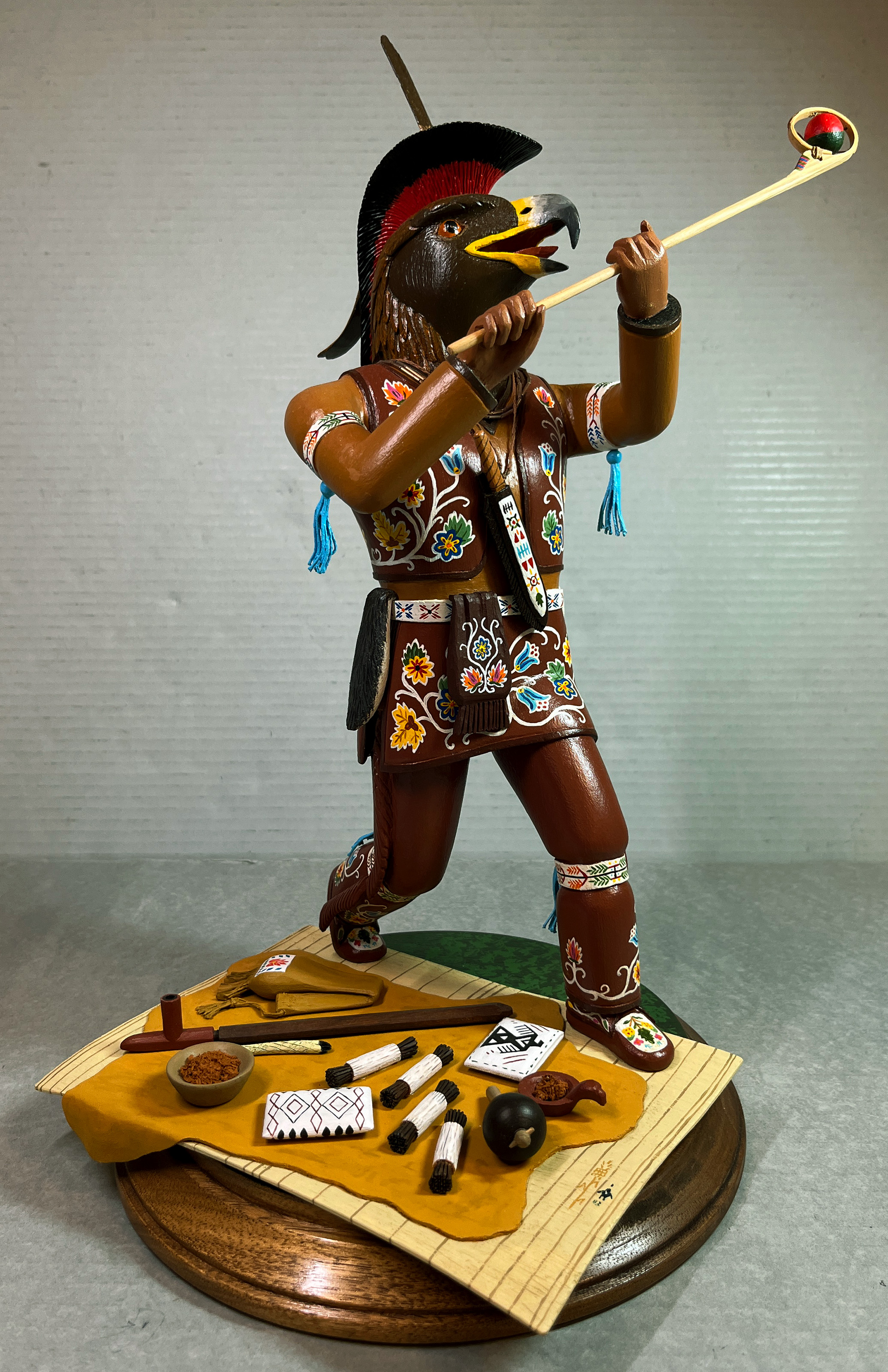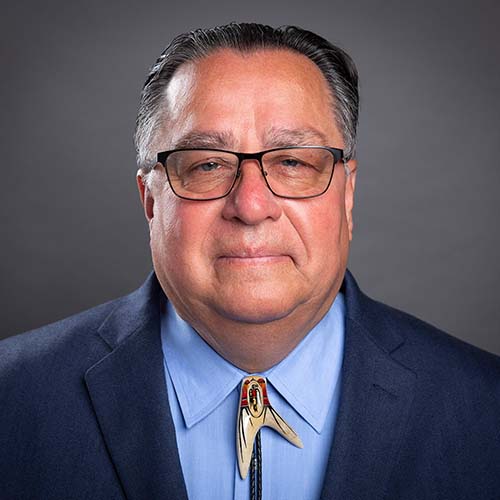
- Details
- By Morgan Clark, Field Museum
Takapsicapi, Peekitahaminki, and Caabnąįkiisik are just a few names of the game played in North America long before French settlers arrived and gave it their own name: “lacrosse.”
Lacrosse is the oldest sport in North America’s history. To people Indigenous to North America, it’s more than just a game: it’s a gift from the Creator and a way to teach their children traditional values. A special section of the Field Museum’s gallery Native Truths: Our Voices, Our Stories, called “The Creator’s Game,” highlights this history.
 Kenēw/The Ball Carrier (Golden Eagle Spirit) crafted by James Frechette (Menominee). Lent by David R. Wrone (c) Field MuseumIn Menominee stories, in which the Creator made the earth, he also made spirits in the form of animals. These animals were the first lacrosse players and held their games on fields spanning hundreds of miles across the Great Lakes region, from Green Bay to Chicago to Detroit.
Kenēw/The Ball Carrier (Golden Eagle Spirit) crafted by James Frechette (Menominee). Lent by David R. Wrone (c) Field MuseumIn Menominee stories, in which the Creator made the earth, he also made spirits in the form of animals. These animals were the first lacrosse players and held their games on fields spanning hundreds of miles across the Great Lakes region, from Green Bay to Chicago to Detroit.
While the stories behind, rules of, and reasons for playing the Creator’s Game vary among Tribes and Nations, most early lacrosse matches included 100 to 1,000 men or more. These players used wooden sticks, sometimes with net baskets or pockets attached, and small, deer hide-wrapped balls. Borderless fields could span miles, and games could last days. It was a game played to prepare for war, but it was also a social event where trades were made and disputes settled. Among many Tribes, the game was as much a mystic ceremony as a sport, preceded by complex rituals and a solemn dance.
In the 1800s, the US government began assimilating Native children in boarding schools: a process that included many efforts at cultural erasure, including the prohibition of lacrosse and its replacement with baseball. Native men excelled at baseball, forming organized baseball teams and playing in minor leagues nationwide throughout the 1930s and 1940s.
Some of these baseball players took on an instrumental role in reasserting tribal sovereignty. In Wisconsin, the men on the Ho-Chunk baseball team helped obtain federal recognition of their tribe—a political shift that made way for the return of lacrosse, too. However, the game they played in the twentieth century had changed over time.
While lacrosse was and is still played across Tribes and Nations for many purposes, modern sticks and the most widely-followed rules of the game are based on lacrosse played by Eastern tribes, like the Haudenosaunee. The traditional Great Lakes style of lacrosse played by the Ho-Chunk was seemingly lost following the assimilation of the 1800s.
The Miami Tribe of Oklahoma, another Great Lakes Nation whose original homelands lie within the boundaries of Indiana, Ohio, Illinois, lower Michigan, and lower Wisconsin, began years of research to recover scattered lacrosse knowledge. After decades of playing with modern rules and sticks, members of the Tribe read and searched for historical references on how they played lacrosse before contact with Europeans. They researched how sticks were made, found clues, and sought out other Great Lakes tribal communities, like the Menominee, for their resources and information.
In 2017, George Strack, George Ironstrack, Jodie Gamble, and Gamble’s sons—all members of the Miami Nation— traveled to visit the Menominee Indian Tribe of Wisconsin. There, they met people who still knew the rules and traditions surrounding the game: a lack of “out-of-bounds” territory, players of all ages, a sapling for a goal but no goalies guarding it, wooden balls with holes whistling across the field, and a meal shared by everyone after the game’s end.
They also learned how to make Great Lakes-style lacrosse sticks and brought back this knowledge to other Miami Tribe members, like Doug Peconge.
 Great Lakes-style lacrosse stick made by Doug Peconge Photographer(s): Doug Peconge (c) Doug Peconge
Great Lakes-style lacrosse stick made by Doug Peconge Photographer(s): Doug Peconge (c) Doug Peconge
As a young kid, Peconge attended lacrosse games and developed an interest in the sport. As an adult with 17 years of experience in IT and mechanical engineering, an enrolled member of the Miami Tribe, and Kiihkayonki American Rescue Plan Act (ARPA) project manager for the Tribe in Fort Wayne, Indiana, that interest became an opportunity to rebuild a community.
“We had conflicts, wars, loss of land, loss of resources, two removals–all those things take a toll on that cultural knowledge,” said Peconge. “What the tribe has done is pick up those threads of knowledge along the way, and lacrosse is one of those threads.”
Learn more about “The Creator’s Game.”
Help us defend tribal sovereignty.
At Native News Online, our mission is rooted in telling the stories that strengthen sovereignty and uplift Indigenous voices — not just at year’s end, but every single day.
Because of your generosity last year, we were able to keep our reporters on the ground in tribal communities, at national gatherings and in the halls of Congress — covering the issues that matter most to Indian Country: sovereignty, culture, education, health and economic opportunity.
That support sustained us through a tough year in 2025. Now, as we look to the year ahead, we need your help right now to ensure warrior journalism remains strong — reporting that defends tribal sovereignty, amplifies Native truth, and holds power accountable.
 The stakes couldn't be higher. Your support keeps Native voices heard, Native stories told and Native sovereignty defended.
The stakes couldn't be higher. Your support keeps Native voices heard, Native stories told and Native sovereignty defended.
Stand with Warrior Journalism today.
Levi Rickert (Potawatomi), Editor & Publisher
